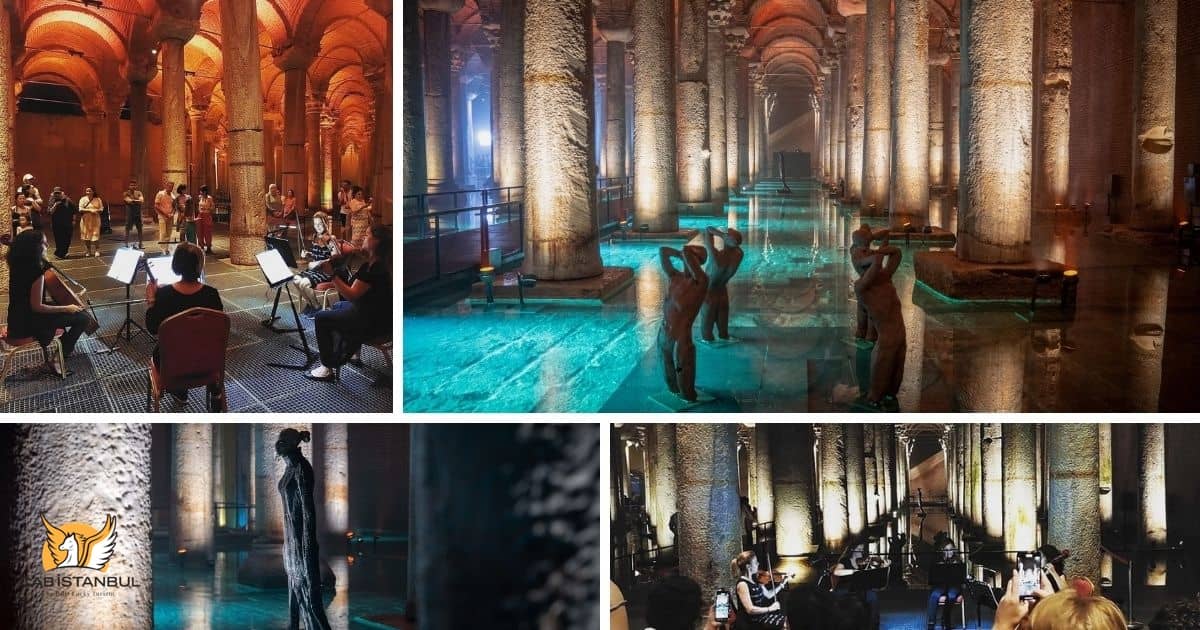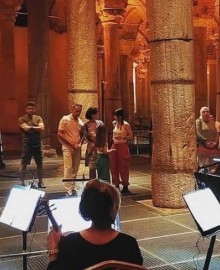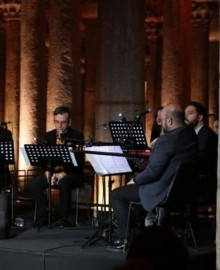Basilica Cistern Istanbul Turkey
2026-01-08

Basilica Cisterna
Basilica Cistern, beneath the bustling streets of Istanbul lies one of its most enigmatic treasures. This ancient marvel, a stone's throw away from the majestic Hagia Sophia, offers a journey back in time, illuminating the ingenious spirit of Byzantine engineering and the mystique of mythological tales. The Basilica Cistern, known locally as the "Yerebatan Sarayı" or Sunken Palace, is not just a testament to the grandeur of the past but a sanctuary of serenity and mystery in the heart of the city. Constructed in the 6th century under the reign of Emperor Justinian I, the cistern was primarily built to address the water supply demands of the Great Palace and surrounding buildings, reflecting the strategic foresight of the Byzantine Empire. Beyond its practical purposes, the cistern's corridors and columns are adorned with artifacts that whisper tales of ancient mythologies, including the enigmatic Medusa heads, which have captivated visitors with their mystifying origins and the myths that shroud them. Discover how to navigate your way to this hidden gem, learn about entry fees, visitation hours, and where to purchase tickets. We'll share insights on what makes the Basilica Cistern a must-visit attraction for countless visitors, including its historical significance, architectural beauty, and the legends that inhabit its corridors. Additionally, we'll offer tips on the best time to visit, allowing you to fully immerse yourself in the mystique of this ancient wonder. Whether you are a history buff, myth enthusiast, or simply in search of Istanbul's hidden treasures, the Basilica Cistern offers an unforgettable exploration into the depths of history and legend, promising a journey that captivates the imagination and the senses.
Experience effortless travel in Istanbul with one of our luxury car and chauffeur services, meticulously designed to facilitate the flawless exploration of the city's numerous historical sites in just a single day. Additionally, don't forget to take advantage of our exclusive affordable airport transfers to your hotel near the Basilica Cistern, ensuring a seamless and comfortable journey from the moment you arrive.
Basilica Cistern Museum
Basilica Cistern History
Architectural Grandeur: Encompassing a sprawling underground expanse of approximately 10,000 square meters, the Cistern boasts the capacity to house around 100,000 tons of water. It flaunts an assembly of 336 columns, each soaring to a height of 9 meters, meticulously arranged in 12 rows of 28, standing at intervals of 4.80 meters. A significant number of these columns, crafted from an array of marble types, were salvaged from pre-existing structures. The Cistern reveals a tapestry of unique column heads, each bearing distinct characteristics and designs. During the renovations between 1955-1960, several columns received reinforcement with concrete layers, altering their original features. Arches seamlessly transfer the ceiling's weight onto these columns, supported by robust walls and a floor both composed of brick and fortified with a thick layer of mortar to ensure waterproofing.
Historical Utility: During the Ottoman era, the Cistern played a pivotal role in irrigating Topkapı Palace's verdant gardens. Its crucial function extended to satiating the water requirements of the Great Palace's inhabitants and the surrounding localities during Byzantine times.
Theodosius Cistern Istanbul
Basilica Cistern, colossal underground water reservoir, veiled in history and architectural grandeur, is a testament to the ingenuity and vision of ancient Constantinople. Located beneath the site of the Stoa Basilica, a significant public square on the First Hill, the cistern's origins trace back to the Early Roman Age, between the 3rd and 4th centuries. Initially serving as a commercial, legal, and artistic center, the area witnessed a transformative era under the auspices of Emperor Constantine and later, Emperor Justinian, who expanded the cistern following the devastating Nika riots of 532. The Basilica Cistern graces Istanbul's historic Sultanahmet area, residing in harmonious contrast beside the illustrious Hagia Sophia. With its inception tracing back 1500 years under the aegis of Byzantine Emperor Justinian, the Cistern is colloquially dubbed "The Palace" due to its maze of marble pillars that majestically pierce through the tranquil waters below. Its alternative name, “Basilica,” harkens to a once-standing Basilica originally occupying the Cistern’s present location.
Rediscovery of a Marvel: The mid-16th century witnessed the Dutch traveler P. Gyllius stumbling upon the Cistern while exploring the vicinity of Hagia Sophia. Intrigued by residents drawing water from well-like holes in their homes, Gyllius embarked on an exploration, delving into the Cistern through stone steps that led him into its cool, echoing depths. Despite challenging conditions, his exploratory journey through the water-filled space allowed him to measure and document the columns, leaving behind a record that inspired many future travelers.
Restoration Chronicles: The Basilica Cistern underwent restoration processes twice during the Ottoman period, with the initial refurbishment led by Architect Mehmet Ağa under Sultan Ahmet III in 1723. Subsequently, Sultan Abdülhamid II oversaw its second restoration between 1876-1909. Following a significant cleanup by Istanbul Municipality in 1987, the Cistern transformed into a museum, welcoming visitors with its newly installed viewing platform. After a subsequent significant cleaning in 1994, it closed for an extensive restoration and finally reopened its gates to the public on July 22, 2022.
Basilica Cisterns Of Istanbul

Basilica Cistern Medusa
A Masterpiece of Roman Sculptural Art: The Heads of Medusa, sculptural masterpieces emblematic of the Roman Period, are discreetly positioned as pedestals beneath two columns in a secluded corner of the Basilica Cistern. The origins of these intriguing heads, seamlessly integrated into the cistern’s architecture, remain shrouded in mystery. Scholars speculate that these heads were purposefully incorporated during the cistern’s construction, serving merely as architectural bases for the columns.
Medusa’s Tale: Medusa, a name that echoes with a chilling resonance, represents one of the three Gorgons in Greek mythology — formidable female entities residing in the underworld, whose petrifying gaze could transmute living flesh into lifeless stone. With their snake-coiled heads and hypnotically menacing glares, Medusa and her Gorgon counterparts have been perennial symbols of dread and fascination.
Over the centuries, artistic renditions of these mythical figures, ranging from paintings to sculptures, have been conceived and revered as protective talismans, safeguarding individuals, possessions, and sacred spaces from malevolent forces. The presence of Medusa's head within the cistern is believed to emanate a protective aura, a concept reminiscent of the evil eye beads in Turkish culture that are thought to ward off misfortune and malevolent glares.
Byzantine Cistern Istanbul
A Tale of Love and Jealousy: The legend paints Medusa as a maiden of unparalleled beauty, possessing entrancing black eyes, cascading waves of hair, and a figure sculpted by the gods themselves. This mesmerizing beauty captivated the heart of none other than Perseus, the divine son of Zeus. However, love’s landscape was marred by the shadows of rivalry, as the goddess Athena, ensnared by her affections for Perseus and green tendrils of jealousy towards Medusa, cursed the beautiful maiden. In the wake of Athena’s curse, Medusa’s glorious hair transformed into writhing serpents, and her gaze acquired the dreaded power to petrify. Perseus, armed with stealth and valor, eventually severed Medusa’s cursed head, employing its petrifying gaze as a weapon against his formidable foes.
Byzantine Integration of the Medusa Myth: During the Byzantine era, images of Medusa’s head were intricately etched onto sword hilts, serving as symbols of power and protection. Within the shadowed confines of the Basilica Cistern, the Heads of Medusa are strategically positioned upside down upon column bases. This deliberate orientation was believed to neutralize the petrifying effects of Medusa's gaze, preventing it from ensnaring the unsuspecting visitor in a web of eternal stone. The sculptor who immortalized Medusa within the cistern executed the task with meticulous precision, presenting Medusa in three distinct positions, each subtly altered to interact uniquely with the interplay of light and shadow within the cistern’s depths.
Istanbul Sunken Palace

Underground Basilica Cistern
History Meets Contemporary Art at the Basilica Cistern Museum's inaugural exhibition, "Deeper," marries the ancient architectural marvel of the cistern with contemporary art, creating a unique cultural nexus. This exhibition, emerging from extensive restoration, showcases works by artists from diverse backgrounds, including Ali Abayoğlu, Aslı İrhan, and others, inviting visitors on a journey through the layers of time. "Deeper" reflects on art as the essence of life and a medium for healing, set within the cistern's mystical ambiance. It encourages exploration into the depths of creativity and historical significance, offering a dialogue between the past and present
The Basilica Cistern's Enchanting 'Night Shift' Events"
Basilica Cistern transcends its historical roots, emerging as a beacon for cultural and artistic endeavors through its 'Night Shift' events. This architectural marvel, steeped in the city's rich historical tapestry, offers a unique venue where history and art converge in harmony.
'Night Shift' Surprise Concerts Part of the 'Night Shift' series, the cistern hosts surprise concerts between 19:30 and 22:00 on selected days of the week. These events provide a mystical journey for those eager to immerse themselves in the magic of history, all within the cistern's captivating ambiance. Visitors might find themselves serendipitously attending a concert, where the spellbinding synergy of history and art unfolds before their eyes. For up-to-date information on these events, please check [here].
The Basilica Cistern, with its 'Night Shift' events, invites locals and tourists alike to delve into an unforgettable experience where the echoes of the past meet the melodies of the present. It's an opportunity to witness the mesmerizing blend of history and art, all within the enchanting confines of one of Istanbul's most treasured hidden gems.
Basilica Cistern Night Events
Basilica Cistern Ticket
Basilica Cistern Visiting Hours & Entry Fees
Standard Hours (09:00 - 18:30)
Local Visitors: 80 TL
Basilica Cistern Entry Fees
International Visitors: 600 TL
Students: 30 TL
Evening Hours (19:30 - 22:00)
Local Visitors: 250 TL
International Visitors: 1,000 TL
Students: 100 TL
Important Notices:
- -Tickets for visits between 19:30 - 22:00 can only be purchased at the Basilica Cistern ticket office starting from 19:30.
- -The Basilica Cistern is closed to visitors from 18:30 - 19:30 daily due to session arrangements.
- -A valid ID must be presented for discounted and free entries.
The Museum Pass is not accepted as the institution is not affiliated with the Ministry of Culture. - -Both credit card payments and cash in Turkish Lira are accepted; foreign currency is not accepted.
- -Tickets can be purchased online through Passo.
Culture AŞ is not responsible for tickets purchased from sources other than our museum ticket offices and Passo’s online ticket sales channels. Please avoid buying tickets from unauthorized sellers. - -Online ticket purchasers must present an ID at the entrance.
Purchased tickets grant single entry on the day of purchase. No refunds are available. - -Visitors entitled to free admission, including children, individuals with physical and visual impairments, and their companions, can visit the museum free of charge between 09:00 - 18:30 by presenting a valid ID.
- -For security reasons and due to capacity constraints, large items such as suitcases are not permitted inside.
- -Plan your visit to the Basilica Cistern and immerse yourself in the breathtaking beauty and historical depth of this ancient marvel, all while navigating the entry logistics with ease.







Write a Comment !